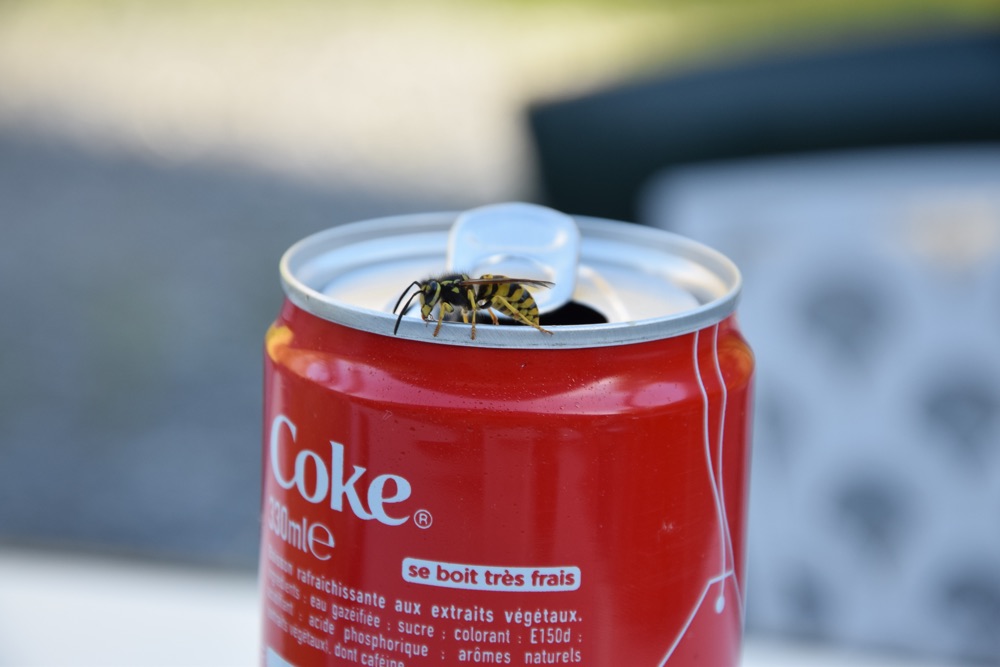Although the wasp has a useful function by catching flies and mosquitoes. They can also be very annoying and even life-threatening. Wasps come in many shapes and sizes because of this there are also different types of nests. Sometimes these nests are built in our immediate vicinity which can cause annoying situations.

Protect Pest Control receives many requests every year to control wasp nests, as this is a very regular occurrence in the Netherlands. Wasps feed their larvae on flies and other insects in the spring. They then feed themselves with a certain sweetness that comes off the larvae. At the end of the wasp year, the queen no longer lays eggs and the workers no longer get any sweetening from the larvae, then they like to feast on ice cream, sweet drinks and fruit. Wasps can become vicious and start stinging if they feel threatened, or think the nest is in danger. People who are allergic to wasp stings should take extra care, but even if you are not, a wasp sting can be very painful. The main component of wasp venom consists of histamine, serotonin and waspkinin. A sting is usually harmless unless it occurs directly into a blood vessel or there is a hypersensitivity to these toxins. Protect Pest Control therefore advises you to have a wasp nest controlled by a professional as soon as possible to avoid the above risks.

The german wasp is bright yellow with black transverse markings on the abdomen. They are between 10 and 15 mm in size. The queen is considerably larger at about 20 mm.
They build a kind of ball and gets bigger and bigger during the season, there can be up to 5,000 wasps in 1 nest. They feed on nectar, small insects and sweetener from the larvae. The german wasp is generally an aggressive species and will sting easily further into the year.

The French field wasp has a slender appearance is about 12 to 18 mm has orange pendulous legs under its body when seen flying. The males have a curve in their antennae and green eyes while the females do not have the curve and have black eyes.
Even though the french field wasps are true sun worshippers, they start building their nests early in the year. They do not make a shell around the combs like the german wasp. The nest is built in sheltered places and does not grow larger than 10 to 20 wasps on 1 nest and unlike the German wasp can have several kings on 1 nest.
The field wasp builds several nests near each other, so there can be 10 nests together and in this way many wasps are present in one place. The wasp can sting, but will not sting as quickly as other wasp species.

The hornet is the largest of its kind at about 28 mm. The queens are a lot larger which are about 35 mm. They are colored yellow, black and brown-red. And build a nest of combs with a roof on top a kind of umbrella hut, a nest contains about 100 hornets.
Hornbills are more focused on their nests and prefer to stay away from people.
They also have no interest in sweetener but feed on small insects, wasps and bees.
Besides the European hornet, the Asian hornet is also on the rise in the Netherlands, these are a lot more aggressive and are a danger to bees.

Wasps are very hard workers. They live in groups together in the wasp nest and everything is about reproduction, something reserved only for the queen. The workers are naturally infertile and do not hibernate, as the young queens do. The nest is made by the wasps gnawing on wood and mixing it with some saliva with which the nest is made. A wasp nest is initially inhabited by only 1 queen who has overwintered, she starts with a small ball when she has also made combs, she will lay eggs because she was fertilized last year. She takes care of the larvae while continuing to build the nest. When the larvae hatch the queen has workers and will stay on the nest to produce more workers and the workers will take care of the new larvae and continue building the nest. At the end of the season, she will produce kings that will fly out to be fertilized. They will then hibernate to start their own nest next season.

Usually you can tell by large numbers of wasps in or around your home or patio that there may be a wasp nest in your area. If one place is being flown in and out that is where the wasp nest is. It is also useful to follow the wasps where they fly so you can find out where the nest is located. The nests are often built in a sheltered place that has an easy entrance and exit to the outside. For example, a porch, eaves, shed in the ground or outbuilding, but they also like and often build in the cavity wall. By late summer, the nest has a large population and you can often easily see the approach route of wasps flying back to the nest.
A fully grown wasp nest may have as many as 5,000 wasps and you can imagine how much of a nuisance this can be during the summer. That is precisely the time when you are probably trying to enjoy the outdoors in the garden, on the terrace or balcony. It is also then that you, your possible children and your guests are at risk of being stung or attacked. Protect Pest Control has customized solutions for every situation that can be used effectively and purposefully. So you will be rid of the nuisance in no time.

When the young queen starts building a wasp nest, in the spring, it is not yet very large. The queen lays the first eggs and these develop into workers, so they can take over the construction in no time. The queen’s job after that is only to lay more eggs to make the population even larger. In addition to building the nest, the workers also have the task of caring for the larvae. Around August, nests are often incredibly large and there can sometimes be as many as 2,000 to 5,000 wasps in a nest. Call Protect Pest Control immediately if you suspect or have discovered a wasp nest, so that it does not grow larger and the wasps have appropriated your fine outdoor space for themselves.
Protect Pest Control can control the wasp nest in a very reliable and safe manner and the wasp nest is therefore often controlled within 1 day. Leaving a wasp nest untreated is highly inadvisable because the wasps can sometimes even survive until the end of the year and the nuisance and risks continue. It is quite common for wasps to be aggressive towards the end of summer, which is why we recommend having us control the wasp nest before this time.
Protect Pest Control is a professional pest control company and uses safe and successful ways to remove the wasps. Trying to remove the nest or control the wasps yourself has proven dangerous in the past. The wasps will be able to attack in swarms when sensing a threat.
Contact Protect Pest Control now to schedule an on-site appointment or for advice and more information.
Protect Pest Control provides advice on control, repellent and prevention as well as a tailor-made solution for your wasp problem. We control the wasp nest with a pesticide which consists of a powder, the powder is sprayed under pressure into the nest after which all wasps come into contact with it. Due to the persistence of the product you can be sure that wasps that come into contact with the nest after the treatment will be controlled.
Protect Pest Control offers you a suitable customized solution after making an appointment, at your convenience. We have years of experience as a pest control company and are certified. In addition, we use the most environmentally conscious manner of control. Protect Pest Control will discuss with you the treatment necessary to achieve the desired result. We also give you advice on prevention after the control.
Do you have certain questions or want to know more about our wasp removal and control services? If so, contact us quickly. By making an appointment today, you can be sure that you will be rid of all wasps in no time.
